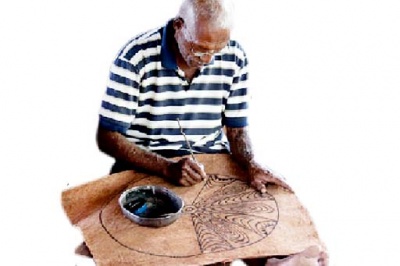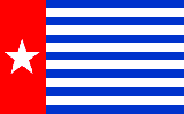 Courtesy of Duty Fine Arts Foundation
Courtesy of Duty Fine Arts Foundation
At first glance, the patterns decorating the red ochre cloths are simple and repetitive — the token fare of mawkish souvenir stalls throughout the Pacific. But look closer, note the strangeness of the bone-white reptilian creatures, spiny fish and swirling wave patterns etched into the beaten bark-cloths.
“Tapa” or bark-cloth is a familiar sight for connoisseurs of traditional tribal art from Australia, the Pacific Islands and Melanesia, and, indeed for tourists as well. But so rarely does Papuan bark-cloth “tapa” travel from their birthplace in Lake Sentani that Duta Art Foundation director Didier Hamel believes his Jakarta exhibition may be the first of its kind in Indonesia.
“Not many people know this type of painting, so it has never been exhibited,” says Hamel. “It takes a long time to find the bark and prepare it. It is quite a process and there’s not really a market, so this exhibition is quite interesting for people to discover.”
The collection includes hundreds of the cloths made by Asei artists hailing from a small island in Lake Sentani, the largest lake in Papua and home to the famous Sentani Lake Festival. The region is known for its arts and especially for Asei bark paintings.
The Duta Foundation’s collection has recently returned from a Houston, Texas, show to be sold in Jakarta. In a book published on the paintings, Hamel and Eddy Juana wrote: “The stylized designs concern spiritual meanings or mutual harmony in social relationships. Common motifs include fishes representing peoples’ livelihood, lizards believed to have particular oracular qualities and snakes expressing the authority of the rulers. Spirals and wavy lines symbolize the swirls of the lake. Some other unusual pieces combine an unexpected blend of Asmat and Sentani motifs.”
In the 1920s, Swiss ethnologist Paul Wirtz made voyages to New Guinea, and his encounters with the mystical qualities of the Papuan bark-cloth style inspired European surrealists including Paul Klee and Max Ernst in the 1930s.
Today, says Hamel, the Sentani people wear the cloths only for cultural festivals, usually donning them as maro skirts or loincloths.
Hamel believes Asei art is rarely encountered in Indonesia because of a number of factors. Travel to Papua was forbidden until quite recently. It is also a long and expensive trip, and, outside of a small group of artists who produce the cloths for tourist consumption, he says it has become a dying art due in part to the long preparation process required.
Traditionally, it is Asei women who gather the bark for “tapa” from old khombouw mulberry, breadfruit or fig trees in Sentani’s tropical rainforest.
The bark is soaked for several weeks, peeled and then pressed flat using heavy stones. Shells are used to plane the bark to a smooth surface and after several weeks of intensive preparations a male Asei artist will begin to paint.
Naturally sourced black, white and red ochre paint give the bark-cloths a distinctive warm hue; their patterns are etched with a bamboo stick that the artist chews as he creates.
The entire collection of Papuan bark-cloths now on show in Kemang is owned by artist and collector Ira Nata Pradja. The countless cloths in the collection are the product of “many, many trips” to Papua, according to Hamel, and are now up for sale.
The collection can be viewed at the Duta Fine Arts Foundation Gallery on Jl. Kemang Utara 55a in Jakarta. Open daily from 10 a.m. to 7 p.m., Sunday from 11 a.m. to 4 p.m., until Feb. 19.
